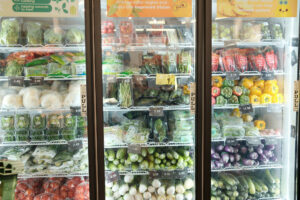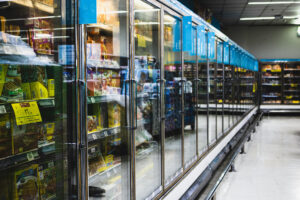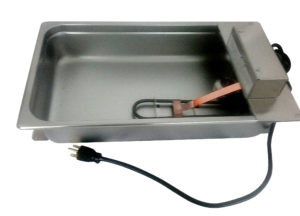Condenser load is the amount of heat removed from the inlet stream to achieve the predefined removal proficiency. It is resolved from an energy balance, considering the enthalpy change because of the temperature change. The commercial refrigeration unit is accepted to supply the coolant at the necessary temperature to the condenser. The capacity of refrigeration required is determined by changing over the condenser load of the refrigeration unit.
How to make things workable
Supermarkets sell a wide range of perishable food sources that require an assortment of commercial refrigeration units to protect and alluringly display various things. The general purpose of a refrigeration case is to cool and store food, subsequently broadening its timeframe of shelf life and usability.
Notwithstanding refrigerated display cases, there are walk-in cooler evaporator. These freezers incorporate produce and dairy product coolers, frozen food, and ice cream storage.
How to select and size a condensing unit
With the developing refrigeration market, you can easily find the Two-Stage Air Cooled Screw Condensing Unit with premium parts. Excellent as refrigeration storage and speedy freezing device in the Reach-In Freezers, the condensing unit is an affordable alternative across the world.
The air-cooled condensing unit is liberated from piston compressors. To defeat this issue, the lunch of the SLLG series low-temperature semi-hermetic condensing unit to satisfy the prerequisites of massive scale refrigeration.
In addition, the manufacture and test of all the Two-Stage Air Cooled Screw Condensing Unit parts done to keep up with the OEM-QUALITY standards cautiously.
Typical System
The refrigeration equipment groups incorporate icemakers and fridges for display and capacity coupled to the mechanical refrigeration machines. The refrigeration unit ranges from the most elevated in the deli meat cases to the least in frozen food storage and display. Open ice cream display cases may have a refrigerant temperature as low as – 40°F.
Pre-assembled display cases are intended to appealingly display food at temperatures that fluctuate as per the item. They might be single-or multi-deck, open, or glass door reach-in freezers. They are not proposed to cool the thing, just keep up with its temperature.
They are altogether influenced by the store’s encompassing air temperature, humidity, and movement. Basic designs have a 75°F dry bulb and 55% relative humidity. Conditions in overabundance of this will genuinely debilitate performance; in any case, lower humidity can bring about critical energy savings: for example, at 35% instead of 55%, savings range from 5% for a glass door reach-in to 29% for multi-deck deli cases.
- Lighting and other radiant heat sources can likewise unfavorably influence performance and temperature.
- Produce and dairy coolers are ordinarily in the 35 to 40°F range with moisture conditions kept in a limited reach to forestall mold, sliming, and dehydration. Low-velocity fan-coil units are regularly used to cool these rooms and have a 10°F distinction between a room and refrigerant temperature. Defrost is typically off-cycle.
- Icemakers might act self-contained to a great extent, reliant upon the degree of ice use (assuming any) in the store.
- The refrigeration unit (high side compressor/condensing units) can go from basic one-compressor and related controls on one refrigerator to an unpredictable central plant that works on all fridges in the supermarket, to multiplexed systems.
- Grocery stores use air-cooled condensing with low-ambient control so the gear can work with the most reduced conceivable head (condensing) pressure needed by extension valves, hot gas defrosting, and (whenever used) heat recovery. Condensers should be appropriately measured to diminish the energy utilization, with an ordinary 10 to 15°F temperature contrast between outside air entering the condenser and soaked condensing temperature. Condensers might be in an air-cooled machine room, distant outdoors or indoors, and used to heat portions of the building in winter.
- Low ambient control utilizing fan cycling is now and again used at temperatures as low as 50°F. Underneath that temperature, condenser flooding arrangements and split condenser coils are common choices.
- Evaporative and water-cooled condensing is less mainstream because of the issues intrinsic for water, its treatment, blowdown removal, and freezing.
Final Words
The refrigeration cycle is transferring the heat consumed by the return chilled water and transferring it to the condenser water, which courses to the cooling tower to deliver the heat to the atmosphere.
Note that most refrigeration units are in the package with the entirety of the accompanying parts: compressor, condenser, extension valve, and evaporator. The refrigerant entering the compressor conveys with it the thermal units moved to it from the chilled water circle.
When it enters the compressor, this refrigerant is in a low pressing factor/low-temperature vaporous state. The compressor “pumps up” the refrigerant into a high acute factor/high-temperature state since temperature increments with the pressing factor of some random refrigerant.
This hot gas goes through a condenser, cooled and dense into a fluid, surrendering its thermal units using warmth trade with the cooling tower circle. Now, the refrigerant is a high pressing factor/high-temperature fluid.
Refrigeration is regularly a massive client of all-year power since this equipment runs in any event when the structure is abandoned. Along these lines, installing the most energy-productive refrigeration unit that your financial plan can deal with is usually most practical.
Subsequently, an energy utility’s delegates ought to be approached to work intimately with the energy client during the early arranging phases of supermarket advancement to help the client best comprehend their alternatives; and to be aware of extension needs consistently and the common substitution of old, wasteful equipment with new, more productive units as portrayed previously.



